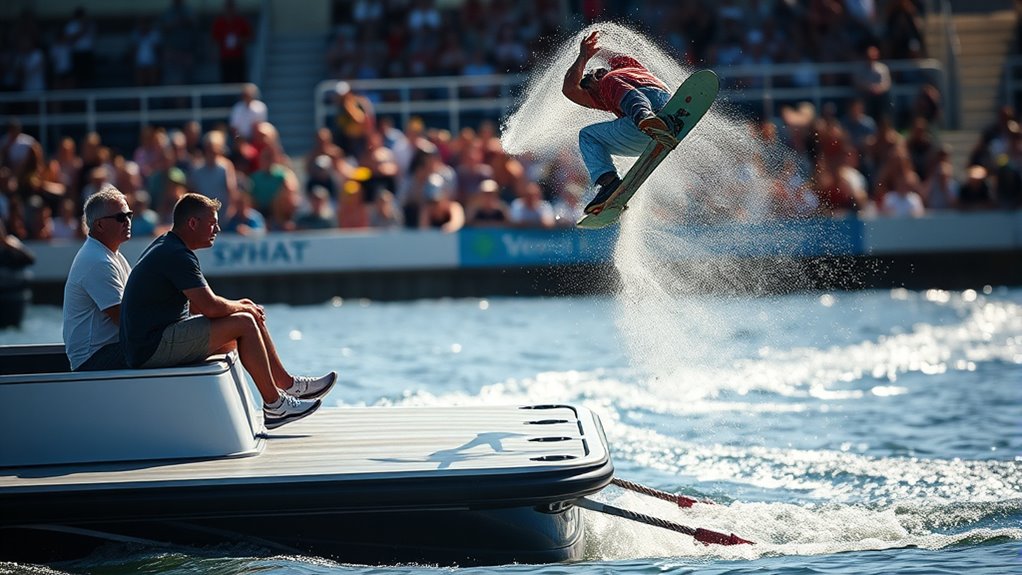In wakeboarding competitions, judges focus on several key factors. They evaluate the difficulty of the tricks, how well you execute them, and your overall style on the water. Smoothness and fluidity are essential, as is the ability to land tricks cleanly and consistently. Displays of control and confidence during your run also impress judges. Plus, showcasing your unique flair can set you apart from the competition. There’s more to mastering the judging criteria, so keep exploring!
Key Takeaways
- Judges evaluate the execution of tricks, focusing on successful landings and overall performance quality.
- Trick difficulty is assessed, with higher complexity yielding more points if executed cleanly.
- Style and presentation play a crucial role, highlighting the athlete’s flair and personality on the water.
- Control and fluidity during runs are essential, as smooth movements enhance overall impression.
- Consistency in trick performance is vital, with clean landings boosting scores significantly.

Have you ever wondered what it takes to stand out in wakeboarding competitions? It’s not just about shredding the waves; there’s a whole world of judging criteria and scoring systems that come into play. Understanding these elements can give you the edge you need to impress the judges and elevate your performance to the next level.
First off, let’s break down the judging criteria. Judges typically evaluate several key aspects of your performance. They’ll look at your tricks, the difficulty of your runs, and your overall style and control on the water. You can’t just throw in a few flashy tricks and expect to score well. Consistency is vital; judges want to see that you can land your tricks cleanly and repeatedly. If you wipe out or struggle to regain your composure, your score will likely take a hit.
Judges assess your tricks, difficulty, style, and control; consistency is key to achieving a high score.
Next, the scoring systems utilized in competitions can vary, but they generally follow a point-based format. Judges assign scores based on the criteria mentioned, and the highest and lowest scores may be dropped to eliminate bias. This means you’ll need to impress multiple judges across different aspects of your run to guarantee your final score reflects your true talent.
You’ve got to be mindful of the difficulty of your tricks, too. While executing simple moves might seem safe, they won’t earn you high points. Instead, consider pushing your limits. Judges reward those who take risks with more complex tricks. However, keep in mind that attempting difficult maneuvers comes with its own set of risks. If you don’t land them cleanly, you might end up scoring lower than if you’d played it safe.
Style and presentation also play a significant role. Your overall demeanor on the water matters. Fluid movements, a confident stance, and smooth progression can all enhance your score. Make sure you’re showcasing your personality and passion for the sport. Judges appreciate riders who exhibit individuality and flair, so don’t be afraid to let your unique style shine through. Additionally, understanding the judging criteria can significantly improve how you prepare for competitions and refine your performance.
Frequently Asked Questions
What Gear Do Wakeboarders Typically Use in Competitions?
In competitions, you typically use a high-quality wakeboard, bindings that fit snugly, and a life vest for safety. Your gear selection is essential, so choose a board that matches your skill level and style. Don’t forget about your rope and handle; they should be durable and comfortable. Regular equipment maintenance is critical, too. Check your bindings for wear and guarantee your board’s edges are sharp for maximum performance.
How Do Weather Conditions Affect Competition Outcomes?
Weather conditions profoundly impact competition outcomes. If you’re competing, strong wind conditions can hinder your performance, making tricks harder to execute. Choppy water caused by wind can also affect your balance and control, leading to mistakes. On the flip side, calm weather usually allows for smoother runs, enabling you to showcase your skills effectively. Keeping an eye on the forecast is vital, as it can dictate your strategy and overall performance.
Are There Age Categories in Wakeboarding Competitions?
Absolutely, there are age divisions in wakeboarding competitions! They typically include youth categories that allow riders to showcase their skills at various stages of development. It’s like a playground where every age group gets a chance to shine, from the youngest enthusiasts to seasoned pros. This structure not only encourages participation but also fosters a sense of community among wakeboarders of all ages, making competitions even more exciting and inclusive!
What Is the Average Duration of a Wakeboarding Competition?
A wakeboarding competition typically lasts around 2 to 4 hours, depending on the number of participants and the format. During this time, judges evaluate performance based on specific judging criteria, including technical difficulty, style, and execution. Each rider’s score reflects their ability to impress the judges within the established scoring system. So, if you’re competing, make sure to showcase your best tricks and style to secure a higher score!
How Can Beginners Get Involved in Wakeboarding Competitions?
To get involved in wakeboarding competitions, start with some competition training. Look for local wakeboarding schools or clubs that offer beginner classes. They’ll teach you essential skills and techniques. Join practice sessions to gain experience and confidence. Set achievable goals, and remember to watch experienced riders for inspiration. Don’t forget to network with fellow wakeboarders; they can share valuable beginner tips. With dedication, you’ll be ready to compete in no time!
Conclusion
So, next time you watch a wakeboarding competition, remember that it’s not just about flashy tricks or impressive style; the judging criteria are meticulously crafted to highlight skill and creativity. Understanding this can deepen your appreciation for the sport. You might even find yourself cheering for specific riders based on their unique approaches instead of just their scores. Embrace the thrill of the ride and the artistry behind each performance—it’ll make the experience even more enjoyable!










